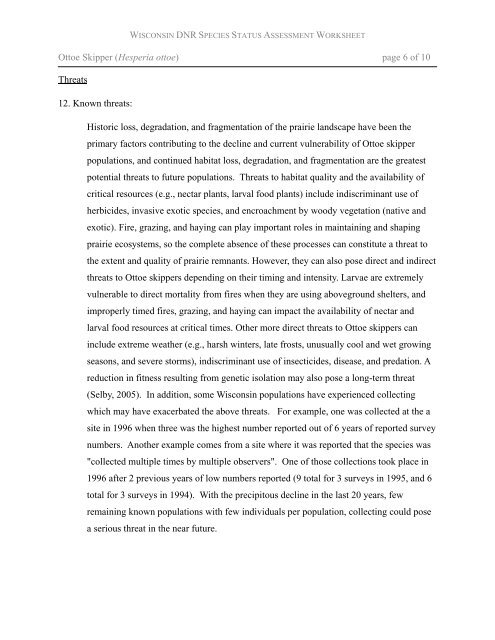Ottoe Skipper - Wisconsin Department of Natural Resources
Ottoe Skipper - Wisconsin Department of Natural Resources
Ottoe Skipper - Wisconsin Department of Natural Resources
You also want an ePaper? Increase the reach of your titles
YUMPU automatically turns print PDFs into web optimized ePapers that Google loves.
WISCONSIN DNR SPECIES STATUS ASSESSMENT WORKSHEET<br />
<strong>Ottoe</strong> <strong>Skipper</strong> (Hesperia ottoe) page 6 <strong>of</strong> 10<br />
Threats<br />
12. Known threats:<br />
Historic loss, degradation, and fragmentation <strong>of</strong> the prairie landscape have been the<br />
primary factors contributing to the decline and current vulnerability <strong>of</strong> <strong>Ottoe</strong> skipper<br />
populations, and continued habitat loss, degradation, and fragmentation are the greatest<br />
potential threats to future populations. Threats to habitat quality and the availability <strong>of</strong><br />
critical resources (e.g., nectar plants, larval food plants) include indiscriminant use <strong>of</strong><br />
herbicides, invasive exotic species, and encroachment by woody vegetation (native and<br />
exotic). Fire, grazing, and haying can play important roles in maintaining and shaping<br />
prairie ecosystems, so the complete absence <strong>of</strong> these processes can constitute a threat to<br />
the extent and quality <strong>of</strong> prairie remnants. However, they can also pose direct and indirect<br />
threats to <strong>Ottoe</strong> skippers depending on their timing and intensity. Larvae are extremely<br />
vulnerable to direct mortality from fires when they are using aboveground shelters, and<br />
improperly timed fires, grazing, and haying can impact the availability <strong>of</strong> nectar and<br />
larval food resources at critical times. Other more direct threats to <strong>Ottoe</strong> skippers can<br />
include extreme weather (e.g., harsh winters, late frosts, unusually cool and wet growing<br />
seasons, and severe storms), indiscriminant use <strong>of</strong> insecticides, disease, and predation. A<br />
reduction in fitness resulting from genetic isolation may also pose a long-term threat<br />
(Selby, 2005). In addition, some <strong>Wisconsin</strong> populations have experienced collecting<br />
which may have exacerbated the above threats. For example, one was collected at the a<br />
site in 1996 when three was the highest number reported out <strong>of</strong> 6 years <strong>of</strong> reported survey<br />
numbers. Another example comes from a site where it was reported that the species was<br />
"collected multiple times by multiple observers". One <strong>of</strong> those collections took place in<br />
1996 after 2 previous years <strong>of</strong> low numbers reported (9 total for 3 surveys in 1995, and 6<br />
total for 3 surveys in 1994). With the precipitous decline in the last 20 years, few<br />
remaining known populations with few individuals per population, collecting could pose<br />
a serious threat in the near future.



![Nature program winter schedule [PDF] - Wisconsin DNR](https://img.yumpu.com/22471254/1/190x245/nature-program-winter-schedule-pdf-wisconsin-dnr.jpg?quality=85)
![City of Middleton [PDF] - Wisconsin Department of Natural Resources](https://img.yumpu.com/22300392/1/190x245/city-of-middleton-pdf-wisconsin-department-of-natural-resources.jpg?quality=85)

![Wetland Conservation Activities [PDF] - Wisconsin Department of ...](https://img.yumpu.com/21975633/1/190x245/wetland-conservation-activities-pdf-wisconsin-department-of-.jpg?quality=85)




![Baraboo River Region[PDF] - Wisconsin Department of Natural ...](https://img.yumpu.com/21975619/1/190x245/baraboo-river-regionpdf-wisconsin-department-of-natural-.jpg?quality=85)




